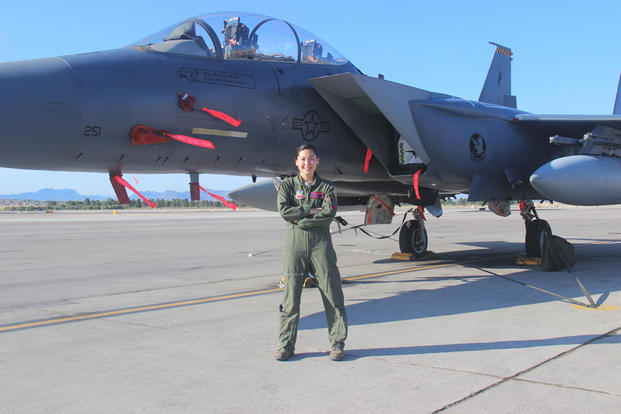MOUNTAIN HOME AIR FORCE BASE, Idaho -- Capt. Kari Armstrong, an F-15E Strike Eagle weapon systems officer with the 389th Fighter Squadron, received more than a diploma from the USAF Weapons School at Nellis AFB, Nevada, June 27. Armstrong also became the first female F-15E WSO and the second female student in a fighter platform--after Col. Jeannie Leavitt in June 1998--to complete the graduate-level school.
While she appreciates the historical aspect of her experience, Armstrong's vision for her future goes beyond her gender. Her ultimate goals are to be the best WSO instructor she can be and to inspire others to excel in the same way her mentors did. Those goals motivated her to apply to the Weapons School in the first place.
Armstrong did not have to put herself through weapons school - a rigorous school that selects only the top three percent of F-15E aircrew and has an elimination rate of 10 percent each class. However, Armstrong had observed and admired the graduates - also known as "Patches" - at her unit for some time.
"I realized that the people I wanted to emulate the most happened to be Patches," explained Armstrong. "They really summed up the 'humble, approachable, credible' motto of the Weapons School. To me, a Patch means being very proficient at your job but also being willing and available to help those around you."
Her skills and teaching acumen resulted in her selection to the 17th Weapons Squadron's F-15E Weapons Instructor Course on her first application to the Weapons School. After arriving, Armstrong soon realized she might be the first female WSO to graduate from the fighter WIC. However, she could not allow herself to think about that. She had to focus on the 260 academic hours, 28 flying missions and a course designed to contain the toughest operational conditions most students ever see.
"Going through the course, I didn't feel singled out. At the end of the day, [gender] doesn't matter in the briefing rooms. All that matters is the quality of your brief, execution and debrief," said Armstrong.
The 17th WPS leadership echoes that sentiment. "Capt. Armstrong's accomplishments are notable simply because of her ability," said Lt. Col. James Blanton, 17th WPS commander. "She's a very good aviator and instructor. Regardless of gender, all of our students will be excellent leaders for the USAF."
Her fellow classmates were essential to Armstrong's success. She advises potential Weapons School students to "stay positive and lean on your classmates for support. Look for the little wins." Small successes during the course are important. They help counter the challenging hours of training and the constructive feedback from instructors.
Throughout the course, Armstrong worked hard to make her family and colleagues proud. She credits her grandfather, a P-51 pilot in World War II, and two uncles who were Air Force pilots for instilling her love of flying and her parents for her work ethic and perseverance. She is grateful to her husband, Capt. Mark Armstrong, an F-15E pilot with the 389th FS, for his unwavering support. Finally, she acknowledges the Patches at her unit who inspired her to apply and encouraged her the entire way.
As she returns to the 389th FS and Mountain Home Air Force Base, Armstrong hopes to encourage other WSOs to apply for the Weapons School. She wants them to know becoming a Patch is an attainable goal; however, "It is not a goal you can complete overnight; it is something you have to work hard at every single day."
"[The Weapons School] is challenging, but it's also the best flying I've ever had the opportunity to participate in," explained Armstrong. "Unless you go to a Red Flag, you won't typically see how all the platforms work together. Getting outside your own bubble helps you see the bigger picture of how we all play a role in the overall mission."
























